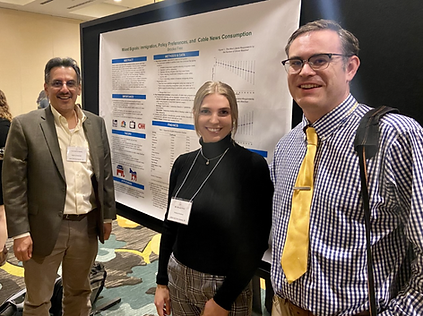Deciphering Data: The Role of Quantitative Analysis in Decision-Making
Unpacking Quantitative Analysis
Quantitative methods, including statistical analysis, mathematical modeling, and visualization, serve as the bedrock of modern decision-making in administration, providing a structured approach to analyzing and interpreting numerical data. As a discipline, it encompasses a diverse range of statistical techniques and mathematical models designed to extract insights and inform strategic choices. In administrative roles, proficiency in quantitative methods is indispensable, empowering professionals to make informed decisions, optimize processes, and navigate complex organizational challenges with precision and confidence. This reflection explores the significance of quantitative methods in administration, delving into their practical applications and the impact it has on organizational effectiveness.
Utilizing Surveys for Informed Decision Making
Surveys are a tool for administrators and data analysts, providing a means to gather crucial information and insights from a target population. This data can then be analyzed to identify trends, patterns, and areas for improvement, informing decision-making processes and guiding strategic planning efforts. However, it is important to recognize that surveys can sometimes be unreliable, particularly if they are poorly designed or administered. I tend to avoid the use of surveys if possible due to the plethora of factors that make them unreliable. However, they remain a useful tool in certain situations, particularly when seeking to gather broad, qualitative feedback from a large group of people. Through my experiences analyzing survey data, I have gained valuable insights into the potential benefits and drawbacks of using surveys as a data collection tool. Working with the employee satisfaction and engagement survey for the City of Pflugerville, I learned firsthand how survey results can drive meaningful organizational change – after analyzing the results of the employee satisfaction and engagement survey, I recommended that the City of Pflugerville create two new positions and adjust their insurance policy to better support their employees, which they subsequently implemented. This experience taught me the importance of carefully designing survey questions and targeting the right population to gather actionable insights. Similarly, my analysis of the U.S. Secret Service's employee satisfaction survey as part of my Quantitative Methods II coursework provided me with hands-on experience in working with complex datasets and drawing meaningful conclusions from survey responses. Through this project, I developed a deeper understanding of the challenges involved in ensuring survey reliability and validity, as well as the importance of approaching survey analysis with a critical eye. I also practiced making recommendations for human resource policies from the survey data insights to enhance the employees' quality of life at work. These experiences have reinforced my belief in the value of surveys as a data collection tool, while also teaching me to be mindful of their limitations and to always strive for rigorous, unbiased analysis.
Data Exploration with SPSS & STATA
STATA and SPSS are statistical software packages widely used by administrators, data analysts, and researchers across various fields. These tools are designed to streamline the process of data analysis, manipulation, and visualization, enabling users to extract meaningful insights from complex datasets. Leveraging STATA and SPSS allows professionals to efficiently handle large volumes of data, conduct a wide range of statistical tests, and create compelling visualizations to communicate their findings effectively. This empowers organizations to make data-driven decisions, identify trends and patterns, and optimize their strategies based on empirical evidence.
SPSS, while being one of the oldest statistical software packages on the market, remains a valuable tool for data analysis. Its longevity is a testament to its reliability and usefulness in handling a range of statistical tasks. Learning to use SPSS provided me with a solid foundation in understanding the fundamentals of data analysis and statistical concepts, which can be readily applied to other software packages like STATA. Even though I have not used SPSS as the primary analytical tool since undergraduate, I use it regularly to quickly import, forecast, and organize data.
My Quantitative Methods I course provided me with hands-on experience using STATA, building upon my prior knowledge of SPSS. Throughout the course, I focused on learning how to manage datasets, perform descriptive and inferential statistical analyses, and create visualizations to present my findings effectively. The course emphasized the importance of thorough data preparation, including cleaning, transforming, and coding variables to ensure the accuracy and reliability of the results. I learned the crucial role that clear and concise communication plays in conveying the significance of my findings to both technical and non-technical audiences. By applying these lessons in my administrative and data analysis roles, I am better positioned to harness the power of statistical software like STATA and SPSS, allowing me to uncover meaningful insights, inform strategic decision-making processes, and ultimately drive more effective outcomes for the organization.
Concluding Thoughts on Quantitative Analysis

My undergraduate faculty mentors (Dr. Juan Carlos Huerta & Dr. Lanie Shay) & me at the Southwestern Social Science Association Conference (April 2022)
My experiences with employee satisfaction surveys with both the City of Pflugerville and the U.S. Secret Service have showcased the impact of quantitative analysis within administrative roles. I learned invaluable insights into crafting effective surveys, refining data, and critically interpreting results. Immersing myself in the intricacies of statistical software like STATA and SPSS during these projects provided me with a more solid understanding of the quantitative analysis processes. With these skills, I can find useful insights and make good decisions. This helps me face challenges head-on and make a real difference in my work as an administrator and data analyst.